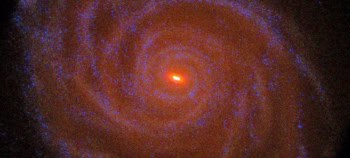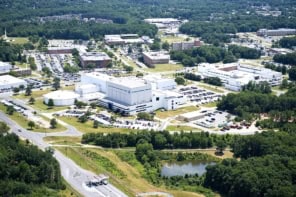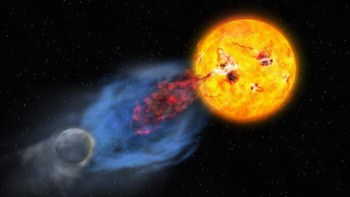The Square Kilometre Array (SKA) promises to usher in a new era in radio astronomy. Astronomers will use the telescope to probe the early universe by looking as far back in time as the first 100 million years after the Big Bang. It will also be employed to search for life and planets, as well as to study the nature of dark energy. This video takes you on a tour of the sites in Australia and southern Africa that will host the SKA, featuring artists’ impressions of the impressive telescope equipment. The film will also transport you to the headquarters of the SKA Organisation in the UK, where scientists and engineers describe the challenges and opportunities that lie ahead.
When completed, the SKA will be the world’s largest radio telescope, with a total collecting area of one million square metres. Construction of the first phase is scheduled to begin in 2018. This will see an array of 254 dishes being built in South Africa’s Karoo region covering the bulk of the high and mid-frequencies of the radio spectrum. Meanwhile, the Murchison region in Western Australia will host the low-frequency section of the array with 96 dishes accompanied by approximately 250,000 individual dipole antennas.
Engineers involved in the SKA project are full of impressive facts about the scale of the technology infrastructure. For instance, they say that the number of data being collected by the array will be equivalent to 10 times the global Internet traffic. And given its processing capabilities, the array will be able to survey the sky 10,000 times faster than any existing radio telescope and at a sensitivity that is 50 times greater. To put the latter figure in perspective, it means that the SKA would be able to detect an airport radar signal on a planet tens of light-years away.
“I think it’s fair to say that the SKA really represents the next step in the evolution of low-frequency radio astronomy,” says Jeff Wagg, a SKA project scientist featured in the film. “Observing the universe at low radio frequency not only tells us about the evolution of gas in our own galaxy and other galaxies, but also tells us about the evolution of star formation in the universe.”
In addition, the film takes a look at some of the precursor telescope arrays that are being developed in both host nations as a means of testing some of the SKA technologies. South Africa has the MeerKAT array, which is currently under construction in the Karoo and had the first of its 64 antenna inaugurated in March. Meanwhile, Australia has the Murchison Widefield Array (MWA), which is already up and running. It also has the Australian Square Kilometre Array Pathfinder (ASKAP), which astronomers are currently commissioning and testing.
“There are some really exciting images coming out of those instruments right now,” says SKA engineer Roshene McCool, referring to developments at ASKAP and MeerKAT. McCool says that as well as being important scientific instruments in their own right, the SKA precursor projects will also return a lot of practical information about building telescope arrays in these environments. “The design and the construction of those telescopes has built both infrastructure and also human capital in those areas so that we have skilled people who understand what is actually quite a specialized area,” she says.
The July issue of Physics World features an update on the SKA project, including the surprise news that Germany has announced its intention to withdraw from the project. Members of the Institute of Physics (IOP) can read the article via the digital edition of the magazine or by downloading the Physics World app for iPhone or iPad that is available from the App Store. Remember that if you’re not yet a member, you can join the Institute as an IOPimember for just £15, €20 or $25 a year. Being an IOPimember gives you a full year’s access to Physics World both online and through the app.



